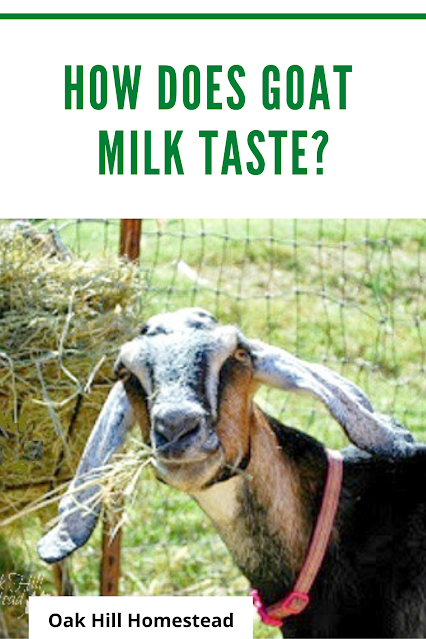It's a question I hear often: what does goat milk taste like?
Some of the people asking have tasted the nasty goat milk from the grocery store; others have heard rumors and tales of how "goaty" it tastes. They wonder if goat milk tastes bad.
Does goat milk taste different from cow milk?
Properly handled, fresh goat milk tastes good. It is very similar to whole cow's milk. Most people can't even tell the difference.
Canned goat milk from the grocery store does taste pretty bad, in my opinion. But I'm used to delicious, fresh goat milk. I think canned cow's milk from the grocery store tastes pretty bad too.
But canned milk isn't good-tasting, fresh milk, so I think comparing canned milk to fresh milk is like comparing apples to oranges. Both apples and oranges are round and grow on trees, but that's where the similarities end.
Likewise, canned milk and fresh milk are both milk, but that might be the only thing they have in common.
The taste of milk is affected by many factors
Factors that affect the taste of goat milk include
- freshness
- the goat's diet
- her environment
- how the milk is handled after milking
- genetics
Those same variables affect cows' milk too.
Cows' milk from the grocery store has been processed, pasteurized and homogenized, with sugar, vitamins and other ingredients added. (Yes, grocery-store milk contains added sugar!) The milk will taste the same from one carton to another. The milk from one particular cow isn't recognizable.
Grocery store goat milk is also processed, and it all tastes the same too. One carton is the same as another.
If you milk a few goats of your own, you might be able to tell the difference in taste from one goat to another. Some goats' genetics will affect the flavor of their milk, at least in my experience.
Fresh milk also tastes different depending on the stage of lactation. It tastes different in the summer than it did in the spring.
Fresh goat milk tastes best
If you were to buy goat milk in a carton from the refrigerated dairy section of the grocery store, keep in mind that the milk is several days away from the goat. It's not fresh.
On the other hand, if you own your own goat and collect fresh milk every morning, that milk is fresh. The taste will prove it.
My family drinks this morning's milk because it's the freshest and sweetest. I'll cook with yesterday's milk (mashed potatoes, macaroni and cheese, all those recipes that need milk), and anything older than that is fed to the dogs or frozen to use in goat milk soap.
The older goat milk is, the stronger it tastes. By the time a carton of goat milk gets into the supermarket cooler, it tastes nothing like the sweet milk my goats gave us this morning.
The goat's diet affects the taste of her milk
Many plants, weeds and herbs will affect the taste of the milk.
Eating wild onions, for instance, will give the milk an onion-y taste. Personal experience has shown us that ragweed will change the taste of goat milk, as can other plants and weeds. Another culprit is commercial feed that includes soy.
While our goats are in milk, they are fed good hay and grain for the best taste. Alfalfa is high in protein so it sustains a doe in milk, plus it lends a delicious, sweet flavor to the milk.
Spring clover grows in our goats' pens. Clover is rich and will also help produce delicious and abundant milk.
We restrict access to weeds and brush during milking season, so our milk is fresh and delicious.
Environment affects the taste of goat milk
A goat that lives in a dirty shed, lying around on damp, dirty straw and goat berries, will produce goaty, strong-tasting milk.
Keeping a strong-smelling buck near the does, or in the same pen, can also cause the milk to taste "musky." This is what most people mean when they said it tastes "goaty."
Keeping everything as clean as you possibly can will go a long way to ensuring your goats' milk will be sweet and delicious. Clean their shed and pen often, and move your buck further away from the does' pen.
A doe's health will also affect the taste of her milk.
Milk Handling
How you handle the milk once it comes out of the goat's udder is extremely important to the taste of the milk.
Keep everything clean, clean, clean, from the milk bucket to the jars and lids that store your milk. Use a stainless steel milk bucket or stock pot to milk into, not plastic. It's impossible to keep odors out of plastic.
Milk your goat in the cleanest environment possible.
A concrete-floored milking room is ideal, but if you don't have one available, put the milking stand in the cleanest place possible, clean it thoroughly before and after milking, and don't allow the goats access to it unless they are being milked.
Wash your equipment thoroughly and rinse it very well. Wash your hands before milking.
Shave your goat to help keep the udder clean. Shave the udder and belly at minimum. This YouTube video will show you how.
Clean the goat's udder before milking, and let it dry before milking.
Milk the first few "squirts" into a paper cup or other container and discard it. The rest of the milk will be cleaner and better tasting. This first milk also contains the most bacteria.
Keeping your milk bucket as cold as possible will also help goat milk taste better. Put glass jars in the refrigerator before you go outside to milk so they will be cold when you get back inside (quart-size Mason jars work well).
Filter the milk with a good quality filter. I use this milk strainer with these disposable filters. Filter the milk into the cold jars that were chilling in the refrigerator.
Chill the milk quickly, and keep it cold as possible - I've shared some tips on chilling goat milk here..
Store goat milk in a clean refrigerator. A cut onion in the refrigerator will flavor the milk, so protect your milk jars from odors.
Read more about storing goat milk here.
Drink goat milk while it's fresh. We drink this morning's milk today; tomorrow we will drink tomorrow morning's milk. Day-old milk is used in cooking, and older milk is used to make cheese or soap, or to feed the dogs.
As a goat lover and a homestead gardener, I'm excited to also share my gardening tips with you - from planting seeds to enjoying the fruits (and vegetables) of your labor! You can find my gardening advice and insights right here, so let's dig in and cultivate some fresh, delicious produce together.
Goat genetics affect the flavor of goat milk too
Genetics will also affect the taste of goat milk.
Certain goat breeds tend to produce milk with more or less butterfat, which affects the taste of the milk. The higher the butterfat content, the better the milk will taste, similar to whole cow milk vs non-fat cow milk. Non-fat milk tastes watery because it contains less fat.
Saanans, for instance, are known as the "Holstein of goats," referring to their ability to produce a high quantity of milk. However, their milk contains the least amount of butterfat.
Nubian goats produce milk with the highest butterfat content of the full-size goat breeds at 5%. Nigerian dwarfs, a miniature dairy goat breed, produce milk with even higher butterfat than Nubians (6-10% fat). Milk from the rest of the full-sized dairy breeds, including Alpine, Oberhasli and Toggenburg, contain between 1 and 4% fat.
A doe's particular lineage (her personal genetics) will also affect the taste of her milk. Certain family lines will have sweeter milk than others.
Other considerations
If you are used to drinking low-fat or skim milk from the grocery store, fresh goat milk might taste funny at first. Fresh goat milk is whole milk, with none of the fat removed. Switching from low-fat grocery-store milk to whole grocery-store milk will taste funny too.
It's hard to catch the cream from goat milk because the fat globules are so small, but the cream will eventually separate a bit and rise to the top of the jar.
Simply shake the jar to mix the cream back into the milk.
If you want to use the cream from your goats' milk to make butter, whipped cream and ice cream, take a look at How To Get Cream From Goats' Milk by Leigh Tate, a small ebook available on Amazon.
Leigh explains why it's more difficult to get cream from goat milk than from cow milk, and offers several different ways to separate the cream from the milk.
So how does goat milk taste? It tastes like fresh, delicious milk.
You’ll find all of my posts on raising goats here.
For more homesteading posts subscribe to my weekly-ish newsletter "The Acorn" and join me on Facebook, Instagram and Pinterest. I'd love to see you there!
~~~~~
My mission is to inspire and encourage you to live a simple, joyful life,
no matter your circumstances or where you live. Join me here:
Facebook | Pinterest | Instagram | Subscribe

















